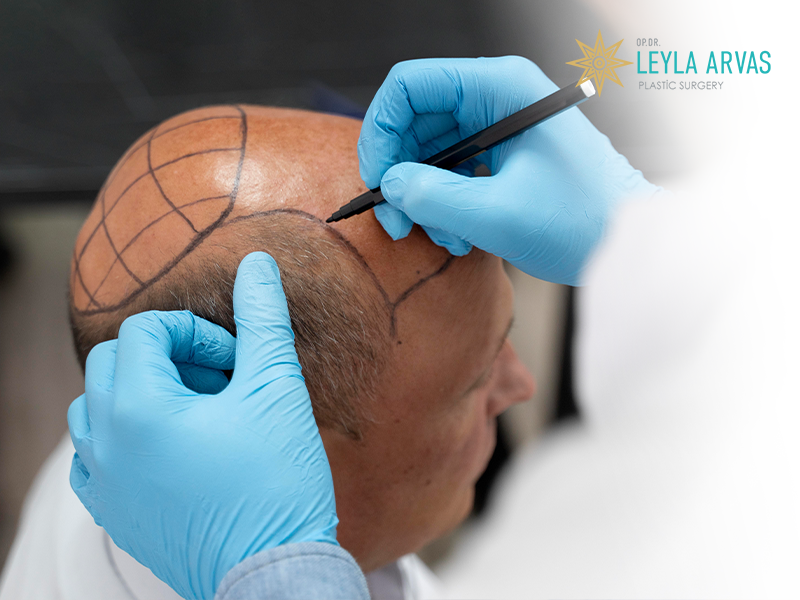
For those who are balding or lost their hair, the FUE hair transplant has been a beacon of hope. Everyone desires thicker hair. Since hair is a natural component of the human body, losing it makes us feel inadequate and out of step with society’s ideal standards.
Psychological issues, irrational outbursts of rage, and subsequently issues with self-confidence are brought on by hair loss. It is not advised to put off hair transplantation because it is now so feasible and common thanks to modern technologies.
FUE hair transplantation procedure is one of the newest and most well-liked hair transplantation techniques. The thick hair of your fantasies is now within reach for you thanks to this hair transplantation technique with a very high success rate.
What’s FUE Hair Transplant?
The FUE hair transplant technique is a hair transplantation procedure that works by individually transplanting hair follicles from the patient’s neck to places where there is no hair. Hairs removed from the body’s back, chest, and legs can be transplanted with this technique.
Shaving the hair and applying local anesthetic to the donor region are the initial steps in the hair transplant procedure after the requisite tests, information gathering, and planning.
Single, double, or triple groups of hair follicles are removed from the donor location and preserved in a specific solution. For a more realistic appearance, the forehead and hairline should be created by the patient and the doctor using the pre-hair loss images as a guide.
Microchannels are opened in the balding region prior to the transplantation of the harvested hair follicles. The most crucial factors in achieving a realistic appearance are the channel’s angle and frequency. The gathered hair follicles are then sequentially inserted into the prepared microchannels to finish the hair transplantation procedure.
Are You A Good Fit For FUE Hair Transplant Method?
You are a good candidate for treatment if your hair loss is moderate and under control or if you would rather prevent scars. This hair transplantation procedure is the ideal option if your donor areas have a low density. The FUE hair transplantation technique is the best approach out of the bunch if you want to cover up scars from earlier surgeries.
If a patient wants to undergo a hair transplant treatment, they can use the FUE technique if they are in excellent health and are of any age. The availability of sufficient donor sites with a high density of hair is another need for FUE. The FUE hair transplantation process has a number of advantages and strengths for the patients. The first time you use this amazing procedure, a speedy recovery is guaranteed. In other words, you quickly regain your youthful appearance after an FUE hair transplantation operation. Additionally, you don’t need to invest a lot of time in it.
How Does FUE Method Work?
One by one, hair follicles are removed from the donor region and prepared for transplantation. There is no surgical treatment involved. The roots are removed one at a time from the back of the hair using 0.7–1 mm micromotor tips, and they are then planted in a sparse or open region. In the empty area, an average of 2,500–3,500 hair transplants can be implanted. No sutures are necessary. The effectiveness of an FUE hair transplant depends on accurately estimating the root density per cm2 to be applied to the transplant region.
The FUE procedure is chosen since it doesn’t leave any obvious marks in the donor area or non-surgical manner. As it is done under local anesthetic, there is no discomfort involved. Although there is no set duration for this treatment, it typically lasts between 5 and 7 hours and should be performed in a hospital or operating room.
Because of this, there is no requirement for sutures, incisions, or other harsh procedures while doing hair transplantation. Additionally, there will be fewer gaps between sessions. This method is therefore more frequently utilized for hair transplants. Hair follicles are individually harvested and moved to the bald region during FUE hair transplantation. Prior to these operations, the donor area’s hair is severely buzzed. Both the location where the hair follicles will be removed and the area where the hair will be transplanted get local anesthetic.
What Are The Benefits Of Getting A FUE Hair Transplant?
Due to the genetic non-shedding property of the hair follicles utilized in FUE hair transplantation, one of the main benefits is that the patient has permanent hair in the transplanted region.
Your hair continues to grow throughout your entire life. The patient’s self-confidence increases and he feels more beautiful as a result of his new hair look. The FUE procedure is recommended because it does not require sutures, among other things. The procedure does not leave any scars.
Men and women can both benefit from FUE hair transplantation. People experience a brief healing period and return to their regular lifestyles without experiencing any pain. The individual’s new hair will seem natural. In the location of the hair transplant, the desired density is readily attained.
Things You Should Do Before Getting A FUE Hair Transplant
Aspirin and other blood-thinning medications should not be used prior to hair transplantation using the FUE procedure. Prior to the operation, the area where the plants will be placed must be clean. Prior to hair transplantation, powerful cosmetic items that will leave a residue on the skin should not be applied. It is advised to wear loose-fitting, comfortable clothing throughout the procedure.
Prior to FUE hair transplantation, the donor subject’s hair is clipped to a diameter of 1 mm. After hair shortening, hair removal from the donor region is initiated. Before beginning the procedure, local anesthetic is used to numb the transplanted location and the donor area from which hair will be removed. This procedure does not involve general anesthesia. In addition, the methodology does not cover any surgical procedures.
The rear of both ears’ napes is typically used to determine the donor area. If the hair at the nape area is not strong enough in certain cases, the hair on the patient’s arm may be used as a donor area instead. And from this region, the required grafts are supplied.
Following the administration of local anesthetic, the hair follicle is separated from the skin by bringing the micro-motor tip in the direction of the hair shaft’s departure to capture the hair root. The same technique is used for hair transplantation in the targeted location once the required number of grafts have been taken.
What Happens During FUE Hair Transplant?
The patient had a very simple and comfortable FUE procedure. Using local or general anesthesia, the practitioner numbs the patient. Depending on the number of hair follicles that will be transplanted, the procedure may take several hours. The procedure may often be finished in a single session by the medical staff. If they are working in a larger region, it can need many sessions to finish. FUE takes longer than FUT since each hair follicle is removed and implanted separately.
The patient can go home once the procedure is over. Outpatient procedures include hair transplant surgery. This implies that patients are not required to spend the night in the hospital. They can return home with the help of a family member or friend once the anesthetic effect has left their bodies. Patients shouldn’t go home alone and drive themselves. They shouldn’t be left alone for a few days either. Even if the procedure is small, problems are still a possibility.
After Hair Transplant
It will take a few months after the FUE procedure before the new hair is evenly spaced from the surrounding hair. The patients will begin to see changes in their hair after their recuperation is totally complete. The brand-new hair will meld into its surroundings. The hair will also be strong and lustrous, like the rest of the head, which is resistant to hair loss. They won’t lose their strength over time because the follicles were removed from the donor region, which is resistant to balding.
The patient’s hair maintenance regimen can continue. They are free to brush, style, and cut it any way they like. Once the healing is complete, there are no constraints on this. The majority of patients are really pleased with the final result. Since hair makes up a significant portion of one’s overall appearance, losing it undermines confidence. The patient’s confidence will return thanks to their new hair, which will also help them feel better about themselves.
First Wash After Hair Transplant
Starting the day our doctor advises, you should start washing your hair. On average, this occurs three days following the patient’s initial clinic wash.
Avoid using boiling or freezing water while washing your hair and instead use lukewarm water. The region undergoing hair transplantation should be handled delicately. The doctor’s prescribed shampoo and lotion should be used for the first two weeks. However, when the hair is being washed and foamed, the transplanted region should never be touched, and the hair should be rinsed after the shampoo has foamed just a little.
Never rub with a towel when drying; instead, use a hairdryer in a warm setting and at a distance. The towel can only be lightly pressed against the skin to absorb the excessive moisture. Except on the doctor’s advice, never topically apply a solution, gel, etc. to the hair. The doctor should be in complete charge at all times, and nothing should deviate from his or her recommendations.
FUE Hair Transplant Recovery Process
The healing process takes the same amount of time as surgery. The patient is in charge at this stage. It’s crucial to call your doctor as soon as any issues arise. Doctors advise against treating problems since doing so might result in irreparable harm. The FUE recovery process often goes extremely well and without any issues.
Patients must refrain from a few key items during this time. These include things like headwear, tugging or combing your hair, drinking, and smoking. Patients should stop using blood thinners or seek alternatives. Smoking and alcohol consumption lengthen the healing process. Additionally, the patient should refrain from using any shampoos or other hair products against the doctor’s advice. They may shield their scalp from damaging substances in this way. The required shampoo for washing their head will be prescribed by the doctor.
Even though the majority of patients have trouble-free FUE healing times, issues are nevertheless possible. The use of anesthetic during surgery might result in complications. It is possible to have swelling, bleeding, infections, blood clots, allergic reactions, etc. Although they are extremely unlikely, things do happen occasionally. It is necessary to inform the patients about these.
Shock Loss After FUE
In most patients, shock loss happens. When they see shock loss, patients often experience anxiety, although this is totally natural. When the hair strands fall out of the hair follicles, shock loss occurs. A doctor should be notified if the hair follicles also start to fall out. A second session might be scheduled if the loss of hair follicles is excessive. The follicles often do not fall out, and after a few weeks, regular hair begins to come out. After some time, the new hair will blend in with the others.
Can You Combine FUE Hair Transplant With Other Treatments?
In most cases, FUE hair restoration is paired with face and neck lifts, double chin liposuction, or eyelid surgery. Injections of Botox, dermal fillers, and energy-based skin treatments are effective non-surgical options.
There shouldn’t be any harm done to the FUE hair transplant surgery. You won’t be able to feel any discomfort throughout the operation since local anesthetic is utilized to numb the scalp region. In comparison to conventional hair transplant techniques, recovery is also less painful.
